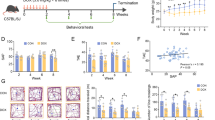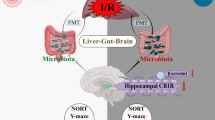Abstract
Rationale
Approximately 20–40% of patients with cancer will experience brain metastasis (BM), which has a great impact on the quality of life and survival rates of patients. Whole brain radiotherapy (WBRT) is an effective method for the treatment of BM. However, it cannot be ignored that WBRT might induce a series of neuropsychiatric side effects, including cognitive dysfunction (CD). Accumulating evidence shows that the gut microbiota and the gut-microbiota–brain axis may play a vital role in the pathogenesis of CD.
Objective and methods
We adopted WBRT to mimic CD after a hierarchical cluster analysis of the Morris water maze test (MWMT) results. In addition, we observed the effects of antibiotics and prebiotics on WBRT-induced CD. Variations were revealed via the 16S rRNA sequencing analysis at different levels.
Results
The 16S rRNA sequencing analysis revealed an altered composition of gut microbiota between CD and non-CD phenotypes. Furthermore, we observed a decrease in the levels of Phylum-Bacteroidete, Class-Bacteroidia, and Order-Bacteroidales in the CD group and an increase in the Genus-Allobaculum level after WBRT. Pretreatment with antibiotics caused a significant decrease in the level of Phylum-TM7 01, whereas an increase in the levels of Class-Gammaproteobacteria, Order-Enterobacteriales, and Species-Escherichia coli. After pretreatment with probiotics, the levels of Phylum-Cyanobacteria, Class-4C0d-2, and Order-YS2 were decreased, while the levels of Family-Bacteroidaceae, Genus-Bacteroides, and Species-Parabacteroides distasonis were increased.
Conclusions
WBRT-induced CD might be highly related to abnormal composition of gut microbiota. Strategies improving the composition of the gut microbiota may provide beneficial effects on CD in individuals exposed to WBRT.









Similar content being viewed by others
Abbreviations
- CD:
-
Cognitive dysfunction
- MWMT:
-
Morris water maze test
- WBRT:
-
Whole brain radiotherapy
References
Akbari E, Asemi Z, Daneshvar Kakhaki R, Bahmani F, Kouchaki E, Tamtaji OR, Hamidi GA, Salami M (2016) Effect of probiotic supplementation on cognitive function and metabolic status in Alzheimer’s disease: a randomized, double-blind and controlled trial. Front Aging Neurosci 8:256
Akkasheh G, Kashani-Poor Z, Tajabadi-Ebrahimi M, Jafari P, Akbari H, Taghizadeh M, Memarzadeh MR, Asemi Z, Esmaillzadeh A (2016) Clinical and metabolic response to probiotic administration in patients with major depressive disorder: a randomized, double-blind, placebo-controlled trial. Nutrition 32:315–320
Barnholtz-Sloan JS, Sloan AE, Davis FG, Vigneau FD, Lai P, Sawaya RE (2004) Incidence proportions of brain metastases in patients diagnosed (1973 to 2001) in the Metropolitan Detroit Cancer Surveillance System. J Clin Oncol 22:2865–2872
Berghoff AS, Schur S, Fureder LM, Gatterbauer B, Dieckmann K, Widhalm G, Hainfellner J, Zielinski CC, Birner P, Bartsch R, Preusser M (2016) Descriptive statistical analysis of a real life cohort of 2419 patients with brain metastases of solid cancers. ESMO Open 1:e000024
Blacher E, Bashiardes S, Shapiro H, Rothschild D, Mor U, Dori-Bachash M, Kleimeyer C, Moresi C, Harnik Y, Zur M, Zabari M, Brik RB, Kviatcovsky D, Zmora N, Cohen Y, Bar N, Levi I, Amar N, Mehlman T, Brandis A, Biton I, Kuperman Y, Tsoory M, Alfahel L, Harmelin A, Schwartz M, Israelson A, Arike L, Johansson MEV, Hansson GC, Gotkine M, Segal E, Elinav E (2019) Potential roles of gut microbiome and metabolites in modulating ALS in mice. Nature 572:474–480
Brickman AM (2013) Contemplating Alzheimer’s disease and the contribution of white matter hyperintensities. Curr Neurol Neurosci Rep 13:415
Brickman AM, Honig LS, Scarmeas N, Tatarina O, Sanders L, Albert MS, Brandt J, Blacker D, Stern Y (2008) Measuring cerebral atrophy and white matter hyperintensity burden to predict the rate of cognitive decline in Alzheimer disease. Arch Neurol 65:1202–1208
Capizzano AISA, Acion L, Bekinschtein T, Furman M, Gomila H, Martinez A, Mizrahi R, Starkstein SE (2004) White matter hyperintensities are significantly associated with cortical atrophy in Alzheimer’s disease. J Neurol Neurosurg Psychiatry 75:822–827
Chang CJ, Lin CS, Lu CC, Martel J, Ko YF, Ojcius DM, Tseng SF, Wu TR, Chen YY, Young JD, Lai HC (2015) Ganoderma lucidum reduces obesity in mice by modulating the composition of the gut microbiota. Nat Commun 6:7489
Consortium" THMP (2012) Structure, function and diversity of the healthy human microbiome. Nature 486:207
Constine LS, Konski A, Ekholm S, McDonald S, Rubin P (1988) Adverse effects of brain irradiation correlated with MR and CT imaging. Int J Radiat Oncol Biol Phys 15:319–330
Costa M, Garcia M, Costa-Rodrigues J, Costa MS, Ribeiro MJ, Fernandes MH, Barros P, Barreiro A, Vasconcelos V, Martins R (2014) Exploring bioactive properties of marine cyanobacteria isolated from the Portuguese coast: high potential as a source of anticancer compounds. Mar Drugs 12:98–114
Costa M, Rosa F, Ribeiro T, Hernandez-Bautista R, Bonaldo M, Goncalves Silva N, Eiriksson F, Thorsteinsdottir M, Ussar S, Urbatzka R (2019) Identification of cyanobacterial strains with potential for the treatment of obesity-related co-morbidities by bioactivity, toxicity evaluation and metabolite profiling. Mar Drugs 17:280
de De-Paula V Jr, Forlenza AS, Forlenza OV (2018) Relevance of gut microbiota in cognition, behaviour and Alzheimer’s disease. Pharmacol Res 136:29–34
Di Rienzi SC, Sharon I, Wrighton KC, Koren O, Hug LA, Thomas BC, Goodrich JK, Bell JT, Spector TD, Banfield JF, Ley RE (2013) The human gut and groundwater harbor non-photosynthetic bacteria belonging to a new candidate phylum sibling to cyanobacteria. Elife 2:e01102
Gophna U, Sommerfeld K, Gophna S, Doolittle WF, van Zanten SJOV (2006) Differences between tissue-associated intestinal microfloras of patients with Crohn’s disease and ulcerative colitis. J Clin Microbiol 44:4136–4141
Gu S, Chen D, Zhang JN, Lv X, Wang K, Duan LP, Nie Y, Wu XL (2013) Bacterial community mapping of the mouse gastrointestinal tract. PLoS One 8:e74957
Islam KBMS, Fukiya S, Hagio M, Fujii N, Ishizuka S, Ooka T, Ogura Y, Hayashi T, Yokota A (2011) Bile acid is a host factor that regulates the composition of the cecal microbiota in rats. Gastroenterology 141:1773–1781
Johannesen TB, Lien HH, Hole KH, Lote K (2003) Radiological and clinical assessment of long-term brain tumour survivors after radiotherapy. Radiother Oncol 69:169–176
Kester MI, Goos JDC, Teunissen CE, Benedictus MR, Bouwman FH, Wattjes MP, Barkhof F, Scheltens P, van der Flier WM (2014) Associations between cerebral small-vessel disease and Alzheimer disease pathology as measured by cerebrospinal fluid biomarkers. JAMA Neurol 71:855–862
Lerner A, Matthias T (2017) Extraintestinal manifestations of CD: common pathways in the gut-remote organs’ axes. Int J Celiac Dis 5:24–27
Ley RE, Backhed F, Turnbaugh P, Lozupone CA, Knight RD, Gordon JI (2005) Obesity alters gut microbial ecology. Proc Natl Acad Sci U S A 102:11070–11075
Ley RE, Turnbaugh PJ, Klein S, Gordon JI (2006) Microbial ecology: human gut microbes associated with obesity. Nature 444:1022–1023
Lo Presti A, Zorzi F, Del Chierico F, Altomare A, Cocca S, Avola A, De Biasio F, Russo A, Cella E, Reddel S, Calabrese E, Biancone L, Monteleone G, Cicala M, Angeletti S, Ciccozzi M, Putignani L, Guarino MPL (2019) Fecal and mucosal microbiota profiling in irritable bowel syndrome and inflammatory bowel disease. Front Microbiol 10:1655
Lopetuso LR, Petito V, Graziani C, Schiavoni E, Paroni Sterbini F, Poscia A, Gaetani E, Franceschi F, Cammarota G, Sanguinetti M, Masucci L, Scaldaferri F, Gasbarrini A (2018) Gut microbiota in health, diverticular disease, irritable bowel syndrome, and inflammatory bowel diseases: time for microbial marker of gastrointestinal disorders. Dig Dis 36:56–65
Manichanh C, Rigottier-Gois L, Bonnaud E, Gloux K, Pelletier E, Frangeul L, Nalin R, Jarrin C, Chardon P, Marteau P, Others (2006) Reduced diversity of faecal microbiota in Crohn’s disease revealed by a metagenomic approach. Gut 55:205–211
Morganti JM, Jopson TD, Liu S, Gupta N, Rosi S (2014) Cranial irradiation alters the brain’s microenvironment and permits CCR2+ macrophage infiltration. PLoS One 9:e93650
Nagao-Kitamoto H, Kamada N (2017) Host-microbial cross-talk in inflammatory bowel disease. Immune Netw 17:1–12
O'Hara AM, Shanahan F (2006) The gut flora as a forgotten organ. EMBO Rep 7:688–693
Provenzano FA, Muraskin J, Tosto G, Narkhede A, Wasserman BT, Griffith EY, Guzman VA, Meier IB, Zimmerman ME, Brickman AM, Alzheimer’s Disease Neuroimaging I (2013) White matter hyperintensities and cerebral amyloidosis: necessary and sufficient for clinical expression of Alzheimer disease? JAMA Neurol 70:455–461
Rogers GB, Keating DJ, Young RL, Wong ML, Licinio J, Wesselingh S (2016) From gut dysbiosis to altered brain function and mental illness: mechanisms and pathways. Mol Psychiatry 21:738–748
Rolhion N, Darfeuille-Michaud A (2007) Adherent-invasive Escherichia coli in inflammatory bowel disease. Inflamm Bowel Dis 13:1277–1283
Shin NR, Whon TW, Bae JW (2015) Proteobacteria: microbial signature of dysbiosis in gut microbiota. Trends Biotechnol 33:496–503
Sperduto PW, Chao ST, Sneed PK, Luo X, Suh J, Roberge D, Bhatt A, Jensen AW, Brown PD, Shih H, Kirkpatrick J, Schwer A, Gaspar LE, Fiveash JB, Chiang V, Knisely J, Sperduto CM, Mehta M (2010) Diagnosis-specific prognostic factors, indexes, and treatment outcomes for patients with newly diagnosed brain metastases: a multi-institutional analysis of 4,259 patients. Int J Radiat Oncol Biol Phys 77:655–661
Suki D (2004) The epidemiology of brain metastasis. In: Intracranial Metastases: Current Management Strategies. Blackwell Futura Publishing, Malden, pp 20–34
Swidsinski A, Weber J, Loening-Baucke V, Hale LP, Lochs H (2005) Spatial organization and composition of the mucosal flora in patients with inflammatory bowel disease. J Clin Microbiol 43:3380–3389
Vorhees CV, Williams MT (2006) Morris water maze: procedures for assessing spatial and related forms of learning and memory. Nat Protoc 1:848–858
Walker AW, Sanderson JD, Churcher C, Parkes GC, Hudspith BN, Rayment N, Brostoff J, Parkhill J, Dougan G, Petrovska L (2011) High-throughput clone library analysis of the mucosa-associated microbiota reveals dysbiosis and differences between inflamed and non-inflamed regions of the intestine in inflammatory bowel disease. BMC Microbiol 11:7
Wilck N, Matus MG, Kearney SM, Olesen SW, Forslund K, Bartolomaeus H, Haase S, Mahler A, Balogh AAS, Mark OL, Others (2017) Salt-responsive gut commensal modulates T H 17 axis and disease. Nature 551:585
Yoshita M, Fletcher E, Harvey D, Ortega M, Martinez O, Mungas DM, Reed BR, DeCarli CS (2006) Extent and distribution of white matter hyperintensities in normal aging, MCI, and AD. Neurology 67:2192–2198
Zhan G, Yang N, Li S, Huang N, Fang X, Zhang J, Zhu B, Yang L, Yang C, Luo A (2018) Abnormal gut microbiota composition contributes to cognitive dysfunction in SAMP8 mice. Aging (Albany NY) 10:1257–1267
Funding
This study was supported by grants from the National Natural Science Foundation of China [81071832 (to X.Y.), 81703482 and 81974171 (to C.Y.), 81571047 and 81771159 (to A.L.)].
Author information
Authors and Affiliations
Contributions
X.L., C.Y., A.L., and X.Y. designed this study and wrote the protocol and the manuscript. X.L., G.Z., S.L., and D.H. performed the experiments. X.L. and G.Z. conducted the statistical analysis. X.L. and C.Y. revised the manuscript. All of the authors contributed to this study and approved the final manuscript and this submission.
Corresponding author
Ethics declarations
All experiments were approved by the Ethical Committee on Animal Experimentation of Tongji Hospital, Tongji Medical College, Huazhong University of Science and Technology (Wuhan, China) and were performed in strict accordance with the Guide for the Care and Use of Laboratory Animals published by the National Institutes of Health (NIH Publications No. 80-23, revised in 1996).
Conflict of interest
The authors declare that they have no conflict of interest.
Additional information
Publisher’s note
Springer Nature remains neutral with regard to jurisdictional claims in published maps and institutional affiliations.
Rights and permissions
About this article
Cite this article
Luo, XX., Yang, C., Zhan, GF. et al. Whole brain radiotherapy induces cognitive dysfunction in mice: key role of gut microbiota. Psychopharmacology 237, 2089–2101 (2020). https://doi.org/10.1007/s00213-020-05520-0
Received:
Accepted:
Published:
Issue Date:
DOI: https://doi.org/10.1007/s00213-020-05520-0




